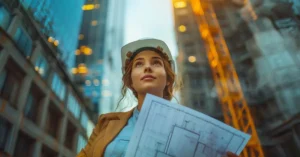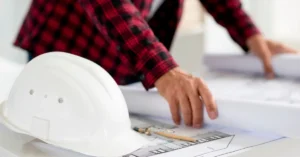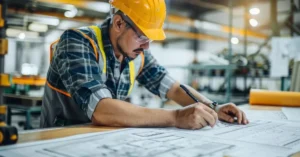ChatGPT, a revolutionary AI-powered chatbot created by OpenAI, has quickly become an invaluable tool for architects and designers. Its ability to generate dynamic and tailored responses to prompts makes it an excellent resource for research, exploration, and ideation. In this article, we’ll explore How to Prompt ChatGPT for Architects to unlock a world of creative design ideas.
Understanding ChatGPT:
ChatGPT, short for Chat Generative Pre-Trained Transformer, is an AI language model that excels in holding interactive conversations. Launched in November 2022, it rapidly gained popularity, becoming the fastest-growing consumer software application in 2023. The brilliance of ChatGPT lies in its prompt engineering, analyzing successive prompts and replies to craft personalized and contextually relevant responses.

How to Prompt ChatGPT for Architects:
To harness the full potential of ChatGPT for architectural projects, architects can follow a simple yet effective prompt formula:
- Setting the Context:
Start with a clear introduction or background information that sets the stage for your question or instruction. This helps ChatGPT understand the topic and provide relevant insights.
Example: “As an architect embarking on a commercial building project, I’m seeking innovative design approaches to create a sustainable and energy-efficient structure.”
- Framing Specific Questions:
Pose your question concisely and with precision, focusing on a particular aspect or problem you want to address. The more specific the question, the more targeted the response will be.
Example: “How can I incorporate renewable energy systems and passive design strategies to reduce the building’s environmental impact?”
- Adding Constraints or Specifics (Optional):
If needed, include additional details or constraints to guide the AI’s response further. This helps ChatGPT consider project-specific factors and provide more tailored suggestions.
Example: “The building site is located in a region with ample sunlight and high wind potential, but it also experiences occasional heavy rainfall and strong winds.”

Sample ChatGPT Prompt for Architects:
“As an architect embarking on a commercial building project, I’m seeking innovative design approaches to create a sustainable and energy-efficient structure. How can I incorporate renewable energy systems and passive design strategies to reduce the building’s environmental impact? The building site is located in a region with ample sunlight and high wind potential, but it also experiences occasional heavy rainfall and strong winds.”
Unlocking Creative Design Ideas with ChatGPT:
By leveraging ChatGPT with well-crafted prompts, architects can gain a wealth of creative design ideas and explore innovative solutions. ChatGPT’s response can act as a collaborative partner, offering unique suggestions that might otherwise be overlooked during traditional research.
Sample Response from ChatGPT:
“Designing a sustainable and energy-efficient commercial building in your region offers exciting possibilities. Here are some innovative design ideas to consider:
- Hybrid Renewable Energy System:
Integrate a hybrid energy system that combines solar panels and wind turbines. This setup takes advantage of the region’s ample sunlight and high wind potential, providing a reliable and renewable energy source. - Rainwater Harvesting and Storage:
Given the occasional heavy rainfall, implement a rainwater harvesting system to collect and store water for non-potable uses like irrigation and flushing toilets. This reduces the building’s reliance on external water sources. - Passive Solar Design:
Orient the building to optimize passive solar heating during colder months. Consider incorporating large windows on the south-facing facade to capture sunlight and passive heat gain. - Wind-Responsive Facades:
Design facades that can adjust their openings based on wind direction and intensity. These responsive facades can promote natural ventilation while protecting against strong winds. - Green Roofs and Walls:
Install green roofs and vertical gardens to enhance the building’s thermal performance, reduce heat island effect, and improve air quality. - Smart Energy Management:
Implement a smart energy management system that optimizes energy usage based on real-time data. This system can automatically adjust lighting, heating, and cooling to conserve energy. - Energy-Efficient Lighting:
Utilize energy-efficient LED lighting with motion sensors and daylight harvesting to minimize energy consumption. - Natural Ventilation Strategies:
Incorporate operable windows and ventilation shafts to encourage cross-ventilation, allowing for passive cooling during warmer months.
Remember to integrate these ideas while considering the building’s functional requirements and aesthetic aspirations. With a thoughtful approach, you can create an iconic and sustainable commercial structure.
Additional Prompt Examples for Architects at Different Project Stages
Initial Conceptualization and Ideation:
Generate ideas for a mixed-use development project in an urban area.
Brainstorm innovative design solutions for a community center focused on sustainability.
Explore creative approaches to integrate nature and biophilic design principles into a residential complex.
Schematic Design and Design Development:
Propose design strategies to maximize natural light and ventilation in a high-rise office building.
Evaluate different facade materials for a museum renovation project, considering aesthetics and durability.
Discuss ways to incorporate inclusive design principles into a public park renovation to accommodate diverse user groups.
Refinement and Finalization of Designs:
Critique the proposed layout and circulation strategy for a hospital complex to optimize patient flow and accessibility.
Assess the structural integrity of a proposed bridge design and suggest improvements for enhanced safety and durability.
Evaluate the environmental performance of a proposed residential development using sustainable design metrics and recommend enhancements.
Addressing Specific Design Challenges:
Brainstorm solutions for minimizing noise pollution in a residential neighborhood near a busy highway.
Propose innovative approaches to address urban heat island effects in a densely populated city center.
Discuss strategies for preserving historic architecture while accommodating modern functionality and accessibility requirements.
Exploring Emerging Technologies and Trends:
Investigate the potential applications of 3D printing technology in architectural design and construction.
Explore the use of virtual reality (VR) and augmented reality (AR) tools for immersive design visualization and client presentations.
Discuss the integration of artificial intelligence (AI) and machine learning algorithms in optimizing building performance and energy efficiency.
Case Studies and Real-World Examples:
Analyze the design principles behind iconic architectural landmarks such as the Sydney Opera House or the Burj Khalifa.
Evaluate the success factors and challenges faced in the adaptive reuse of historic buildings for contemporary purposes.
Discuss the social, economic, and environmental impacts of large-scale urban redevelopment projects in major cities around the world.
Incorporating Sustainability and Resilience:
Propose design strategies for achieving net-zero energy consumption in a residential development.
Explore innovative approaches to water conservation and management in urban landscapes and building systems.
Discuss the role of resilient design principles in mitigating the impacts of climate change on the built environment.
Promoting Community Engagement and Stakeholder Collaboration:
Facilitate a participatory design workshop with local residents to gather input and feedback on a proposed public space revitalization project.
Collaborate with interdisciplinary teams of engineers, landscape architects, and urban planners to develop holistic design solutions for complex urban challenges.
Engage with policymakers and community leaders to advocate for sustainable and equitable development practices in urban planning and design initiatives.
This blog provides a comprehensive guide for architects on how to leverage ChatGPT for unlocking innovative design ideas at every stage of a project, along with a wealth of sample prompts and real-world examples to inspire creativity and foster collaboration.
Conclusion:
ChatGPT serves as a powerful tool for architects, offering a fresh perspective and enhancing their creative workflow. By crafting well-defined prompts, architects can tap into ChatGPT’s vast knowledge and uncover innovative design ideas. As AI technology continues to evolve, its augmentation of the architectural profession is bound to grow, making the design process more efficient and inspiring than ever before. Embrace the potential of ChatGPT, and embark on a journey of limitless creativity in architecture and design.
If you’re interested in learning more about architecture firms in Europe, check out this comprehensive list of the top 50 firms compiled by Archgyan. From innovative startups to long-established industry leaders, this list has it all. Take a look and discover some of the most inspiring and influential architecture firms in Europe today.
If you’re interested in architecture and want to learn more about this amazing field, subscribe to our podcast on youtube
For more SketchUp tutorials, head to https://www.sketchupguru.com













